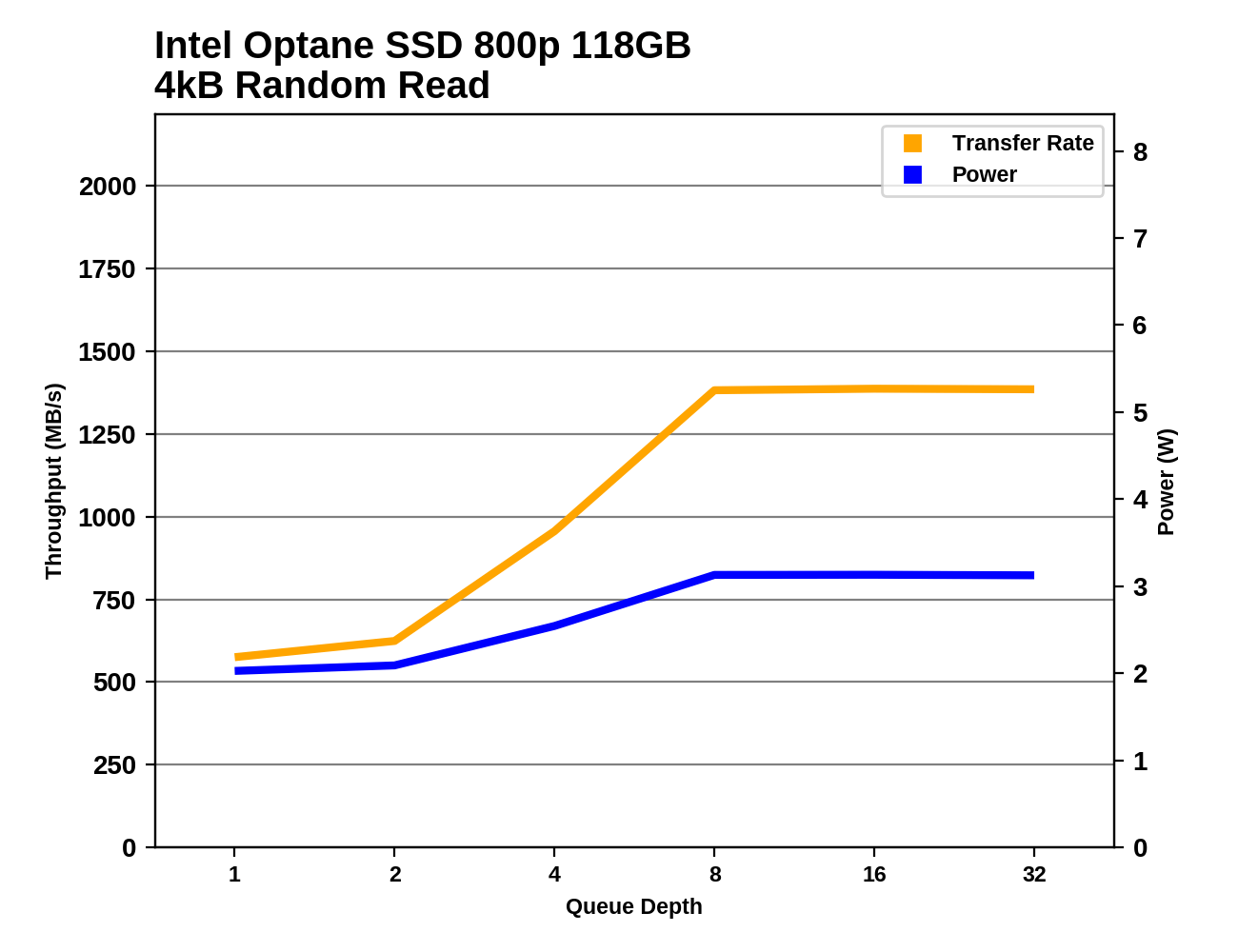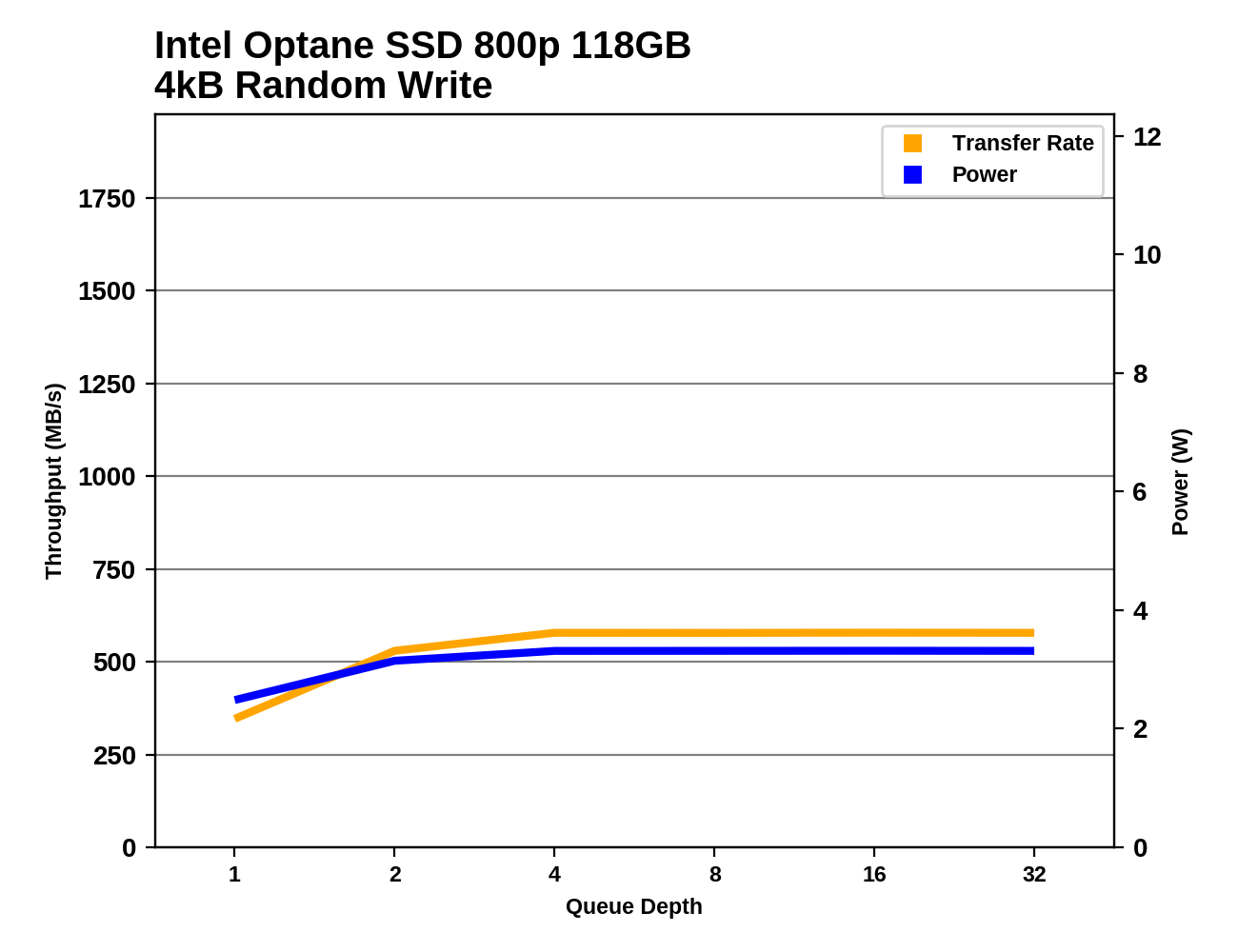The Intel Optane SSD 800p (58GB & 118GB) Review: Almost The Right Size
by Billy Tallis on March 8, 2018 5:15 PM ESTRandom Read Performance
Our first test of random read performance uses very short bursts of operations issued one at a time with no queuing. The drives are given enough idle time between bursts to yield an overall duty cycle of 20%, so thermal throttling is impossible. Each burst consists of a total of 32MB of 4kB random reads, from a 16GB span of the disk. The total data read is 1GB.

Like the Optane Memory M.2, the Optane SSD 800p has extremely high random read performance even at QD1. The M.2 drives even have a substantial lead over the much larger and more power-hungry 900p and its enterprise counterpart P4800X. Even the best flash-based SSDs are almost an order of magnitude slower.
Our sustained random read performance is similar to the random read test from our 2015 test suite: queue depths from 1 to 32 are tested, and the average performance and power efficiency across QD1, QD2 and QD4 are reported as the primary scores. Each queue depth is tested for one minute or 32GB of data transferred, whichever is shorter. After each queue depth is tested, the drive is given up to one minute to cool off so that the higher queue depths are unlikely to be affected by accumulated heat build-up. The individual read operations are again 4kB, and cover a 64GB span of the drive.

The Optane SSDs continue to dominate on the longer random read test, though the addition of higher queue depths allows the 900p to pull ahead of the 800p.

With extremely high performance but lacking the high power draw of the enterprise-class 900p, the Optane SSD 800p is by far the most power efficient at performing random reads.
 |
|||||||||
The Optane SSD 800p starts out in the lead at QD1, but its performance is overtaken by the 900p at all higher queue depths. The flash-based SSDs have power consumption that is comparable to the 800p, but even at QD32 Samsung's 960 PRO hasn't caught up to the 800p's random read performance.
Random Write Performance
Our test of random write burst performance is structured similarly to the random read burst test, but each burst is only 4MB and the total test length is 128MB. The 4kB random write operations are distributed over a 16GB span of the drive, and the operations are issued one at a time with no queuing.

Flash-based SSDs can cache and combine write operations, so they are able to offer random write performance close to that of the Optane SSDs, which do not perform any significant caching. Where the 32GB Optane Memory offered relatively poor burst random write performance, the 800p is at least as fast as the best flash-based SSDs.
As with the sustained random read test, our sustained 4kB random write test runs for up to one minute or 32GB per queue depth, covering a 64GB span of the drive and giving the drive up to 1 minute of idle time between queue depths to allow for write caches to be flushed and for the drive to cool down.

When higher queue depths come into play, the write caching ability of Samsung's high-end NVMe SSDs allows them to exceed the Optane SSD 800p's random write speed, though the 900p still holds on to the lead. The 800p's improvement over the Optane Memory is even more apparent with this longer test.

The power efficiency of the 800p during random writes is pretty good, though Samsung's top drives are better still. The Optane Memory lags behind on account of its poor performance, and the 900p ranks below that because it draws so much power in the process of delivering top performance.
 |
|||||||||
The Samsung 960 PRO and the Intel Optane SSD 900p show off at high queue depths thanks to the high channel counts of their controllers. The Optane SSD 800p doesn't have much room for performance to scale beyond QD2.










116 Comments
View All Comments
patrickjp93 - Saturday, March 10, 2018 - link
Until you start running databases, multi-tenant VM environments, and large swap files for map-reduce, inference drawing, etc..xenol - Monday, March 12, 2018 - link
Yeah, let me know when the average consumer uses that.keralataxi - Monday, March 26, 2018 - link
thank you for sharing this.This site is really helpful to me and i think you have to collect more details about the topic.http://keralatravelcabs.com/tempo-traveller-taxi-s...
JohnBooty - Monday, March 26, 2018 - link
Rrrrrrright. So, yes, a human wouldn't perceive... the latency improvement seen on a single IOP on Octane vs. an alternative.Bravo. That's about as insightful as pointing out that a human also wouldn't notice the difference in latency between a single operation on a 3ghz CPU vs. a 4ghz CPU. Because microseconds, amiirite?
Just for your reference: this is 2018. Unless we're traveling back to 1985 and benchmarking the floppy drive on a Commodore 64, we usually measure the performance or modern by looking at the aggregate performance of thousands or even millions of operations.
Ewitte12 - Monday, April 30, 2018 - link
When something is loading it is rarely doing 1 task. Hundreds or thousands of tasks will definitely be noticeable. You would be surprised how much goes on just loading an app...MrSpadge - Friday, March 9, 2018 - link
No, I can't remember anyone saying that. It was supposed to be an intermediate step between high NAND and DRAM.ATC9001 - Friday, March 9, 2018 - link
It very well may cost less than NAND, but no business in the world is going to sell a product that's faster for less than another one of it's products (unless it simple doesn't sell, which is surely not that case for NAND).I'm pretty excited overall...sure it's hyped up a lot, but remember the first SSDs? Took a while to figure out the controllers and such.
It's great to see the low latency...with DRAM prices the way they are *MAYBE* some enterprise customers will look to optane.
As a gamer, I'm more concerned with sequential performance and higher capacities, but for prosumers with high random workloads this might make sense.
sharath.naik - Sunday, March 11, 2018 - link
More importantly wan't xpoint supposed to have endurance many times over an SLC nand?. The spec here is not much better than an MLC let alone SLCchrnochime - Thursday, March 8, 2018 - link
And FWIW, I value endurance(write cycle) far more than speed. So if it's as fast as SLC I'm okay with that.iter - Thursday, March 8, 2018 - link
Performance means the actual media performance, that includes P/E latency and endurance. slc has great endurance, that I myself would be more than willing to pay for, alas there is no such an option as no slc products have been made the last few years.